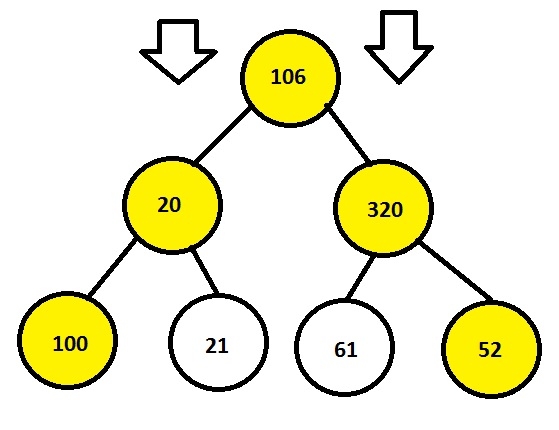
 Data Structure
Data Structure Networking
Networking RDBMS
RDBMS Operating System
Operating System Java
Java MS Excel
MS Excel iOS
iOS HTML
HTML CSS
CSS Android
Android Python
Python C Programming
C Programming C++
C++ C#
C# MongoDB
MongoDB MySQL
MySQL Javascript
Javascript PHP
PHP
- Selected Reading
- UPSC IAS Exams Notes
- Developer's Best Practices
- Questions and Answers
- Effective Resume Writing
- HR Interview Questions
- Computer Glossary
- Who is Who
Print leftmost and rightmost nodes of a Binary Tree in C Program.
Given a binary tree with left and right children and the task is to print the exact right and left child of the given tree.
Leftmost nodes are the nodes which are associated on the left side from the parent node of the tree and rightmost nodes are which are associated on the right side from the parent node of the root.
Example
Input: 106 20 320 100 21 61 52 Output: 106 20 320 100 52

Algorithm
Start Step 1 -> create structure of a node Declare int data Declare struct node *left and *right Step 2 -> create struct node* newNode(int val) Create node* temp=new node Set temp->data = val Set temp->left = temp->right = NULL return (temp) step 3 -> Declare Function void print(node *root) IF root == NULL Return Use STL queue<node*> que Call que.push(root) Use STL vector<int> ans Loop While !que.empty() Set int n = que.size() Loop for int i =0 and i<n and i++ Set node *temp = que.front() Set que.pop() IF i=0 Set ans.push_back(temp->data) End Else IF i=n-1 Set ans.push_back(temp->data) End If temp->left Set que.push(temp->left) End IF temp->right Set que.push(temp->right) End End Loop For auto i : ans Print i End Step 4 -> In main() Declare node *root = newNode(106) to create a node Call print(root) stop
Example
#include <bits/stdc++.h>
using namespace std;
//structure of a node {
int data;
struct node* left, *right;
};
//structure to create a new node
struct node* newNode(int val){
node* temp = new node;
temp->data = val;
temp->left = temp->right = NULL;
return (temp);
}
//function to print corner elements of a tree
void print(node *root) {
if(root == NULL)
return;
queue<node*> que;
que.push(root);
vector<int> ans;
while(!que.empty()){
int n = que.size();
for(int i =0;i<n;i++){
node *temp = que.front();
que.pop();
if(i==0)
ans.push_back(temp->data);
else if(i==n-1)
ans.push_back(temp->data);
if(temp->left)
que.push(temp->left);
if(temp->right)
que.push(temp->right);
}
}
for(auto i : ans)
cout << i << " ";
}
int main (){
node *root = newNode(106);
root->left = newNode(20);
root->right = newNode(320);
root->left->left = newNode(100);
root->left->right = newNode(21);
root->right->left = newNode(61);
root->right->right = newNode(52);
print(root);
return 0;
}
Output
if we run above program then it will generate following output
106 20 320 100 52

Advertisements
